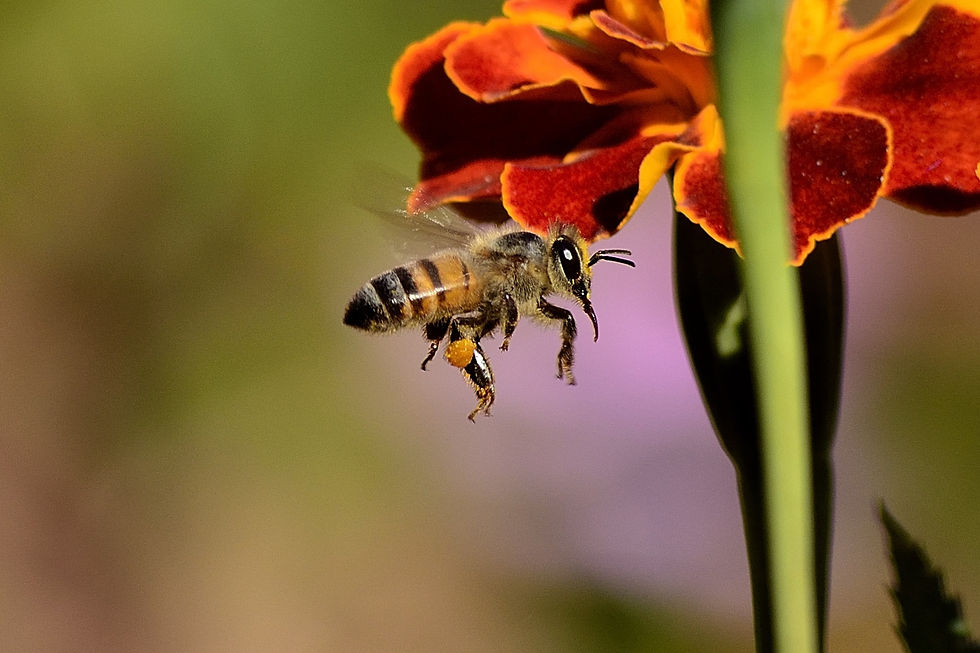When we think of bees, we usually think of their buzzing wings and their ability to produce delicious honey. But there’s so much more to these tiny creatures than meets the eye. Let’s take a closer look at the anatomy of a honey bee.

The Body of a Honey Bee
The body of a honey bee can be divided into three parts: the head, thorax, and abdomen. The head contains the bee’s eyes, antennae, and mouthparts. The thorax is the middle section of the bee’s body, and it’s where the wings and legs are attached. The abdomen is the bee’s rear end, and it’s where the stinger and reproductive organs are located.
Eyes
Bees have two large compound eyes that are made up of many tiny hexagonal lenses. These eyes are very sensitive to light and movement, and they help the bee navigate and locate flowers.
Antennae
Bees also have two antennae on their head. These antennae are covered in tiny sensory hairs that help the bee detect odors and vibrations. The bee uses its antennae to communicate with other bees and to navigate in the dark.

Mouthparts
The bee’s mouthparts are designed for collecting and consuming nectar and pollen. The bee’s long, tube-like tongue, or proboscis, is used to suck up nectar from flowers. The bee also has mandibles, which are used to manipulate pollen.
Wings
The bee has two pairs of wings that are attached to the thorax. The wings are made of a thin, translucent membrane that is supported by veins. The wings can beat up to 200 times per second, allowing the bee to fly up to 15 miles per hour!

Legs
The bee’s legs are covered in tiny hairs that help the bee collect pollen. The bee also has specialised structures on its legs called pollen baskets, or corbiculae, which are used to carry pollen back to the hive.
Abdomen
The bee’s abdomen is where the stinger is located. Female bees have a stinger that is used for self-defence, while male bees do not have a stinger. The bee’s reproductive organs are also located in the abdomen.

Internal Organs
Now that we’ve covered the external anatomy of the honey bee, let’s take a look at its internal organs.
Heart
Bees have a simple heart that pumps their blood, or hemolymph, throughout their bodies. The hemolymph carries nutrients and oxygen to the bee’s cells.
Digestive System
The bee’s digestive system is made up of the foregut, midgut, and hind-gut. The foregut is where the bee’s food is stored, while the midgut is where it is digested. The hind-gut is where waste is eliminated.
Respiratory System
Bees do not have lungs like humans do. Instead, they have a series of tubes called tracheae that carry air to their cells.
Nervous System
The bee’s nervous system is made up of a brain and a series of ganglia, or clusters of nerve cells. The bee’s nervous system is responsible for processing information and controlling its movements.
Reproductive System
The reproductive system of the female bee consists of two ovaries, which produce eggs, and a spermatheca, which stores sperm. The reproductive system of the male bee consists of testes, which produce sperm.
The anatomy of a honey bee! While these tiny creatures may seem simple on the outside, they are actually incredibly complex on the inside. From their compound eyes to their reproductive organs, every part of the bee
References
University of Minnesota Extension. (n.d.). Honey Bees. https://extension.umn.edu/insects/honey-bees
The British Beekeepers Association. (2021). Anatomy of a Honey Bee. https://www.bbka.org.uk/learn/anatomy-of-a-honey-bee
National Honey Board. (n.d.). Honey Bee Anatomy. https://www.honey.com/about-honey/honey-bee-anatomy
ScienceDaily. (2010, May 26). A Bee's Life: Anatomy of the Honey Bee. https://www.sciencedaily.com/releases/2010/05/100526141800.htm
U.S. Department of Agriculture. (2018). Honey Bee Biology and Behavior. https://www.ars.usda.gov/ARSUserFiles/20220500/BeeBiology/BeeBiology2018.pdf
The Bee Cause Project. (n.d.). Bee Anatomy. https://thebeecause.org/bee-anatomy/

Comments